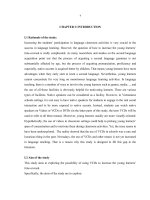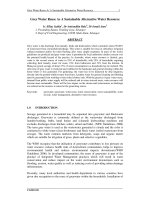Photography composition - Your photo as a story
Bạn đang xem bản rút gọn của tài liệu. Xem và tải ngay bản đầy đủ của tài liệu tại đây (302.31 KB, 8 trang )
Photography composition - Your photo as a story
Photo composition rules
•
Rule of Thirds
•
Golden Section rule
•
Diagonal rule
Tips for beginners
Photo composition software
•
Photo Print Pilot - Photo printing
software
•
Composition Pilot - Make your stories
come true!
"If you, an artist, the one who cannot
manage figures,
you look like an orator who cannot
manage words."
Leonardo da Vinci
Photo composition rules
What is a photograph? It is a story. What is a story? It is is a series of sentences
connected to each other. The same is true about photography. To create a photograph,
it is not enough just to take an image of something. The first impression from a
photograph is determined by the composition balance of an image.
To increase the expressiveness of your digital pictures, apply the picture
composition rules while taking the photos or modeling their edges.
Rule of Thirds
The Rule of Thirds is based on the fact that the human eye is naturally drawn to
a point about two-thirds up a page. Crop your photo so that the main subjects are
located around one of the intersection points rather than in the center of the image:
Your landscapes will be optimally pleasing to the eye if you apply the Rule of
Thirds when you place your horizon line.
If the area of interest is land or water, the horizon line will usually be two-thirds
up from the bottom. Alternately, if the sky is the area of emphasis, the horizon line
may be one-third up from the bottom, leaving the sky to take up the top two-thirds of
the picture:
Golden Section rule
It has been found that certain points in a picture's composition automatically
attract the viewer's attention. Similarly, many natural or man-made objects and scenes
with certain proportions (whether by chance or by design) automatically please us.
Leonardo da Vinci investigated the principle that underlies our notions of beauty and
harmony and called it the Golden Section. Long before Leonardo, however,
Babylonian, Egyptian, and ancient Greek masters also applied the Golden Section
proportion in architecture and art.
To get a clearer sense of these special "Golden" composition points, imagine a
picture divided into nine unequal parts with four lines. Each line is drawn so that the
width of the resulting small part of the image relates to that of the big part exactly as
the width of the whole image relates to the width of the big part. Points where the lines
intersect are the "golden" points of the picture:
Diagonal rule
One side of the picture is divided into two, and then each half is divided into
three parts. The adjacent side is divided so that the lines connecting the resulting
points form a diagonal frame. According to the Diagonal Rule, important elements of
the picture should be placed along these diagonals:
Linear elements, such as roads, waterways, and fences placed diagonally, are
generally perceived as more dynamic than horizontally placed ones:









